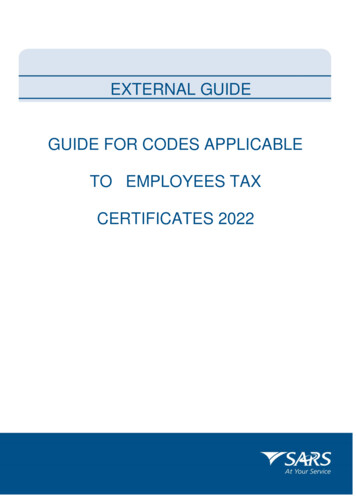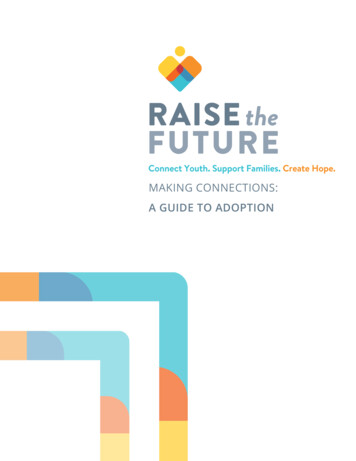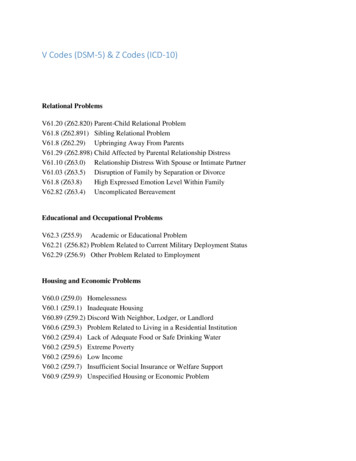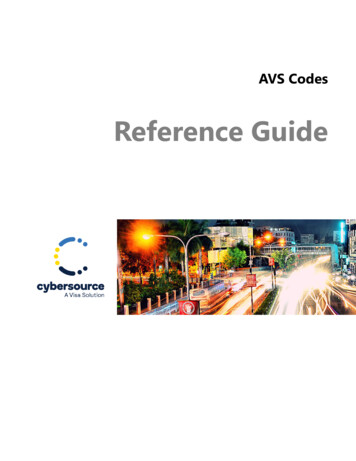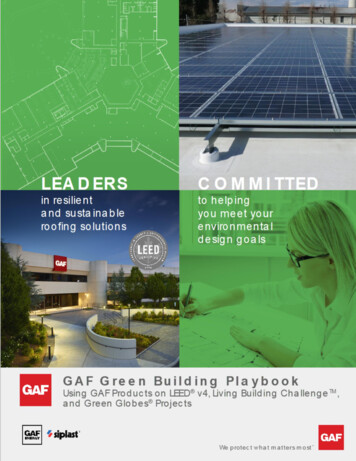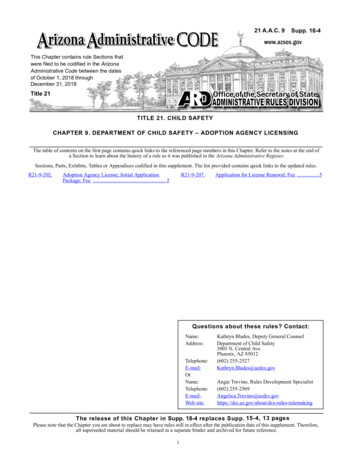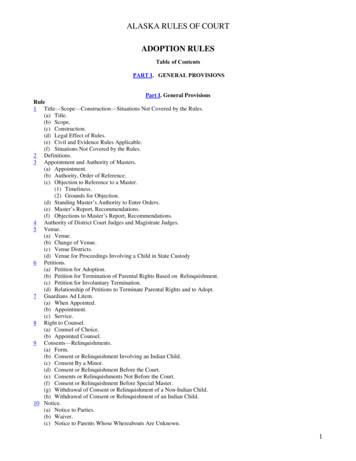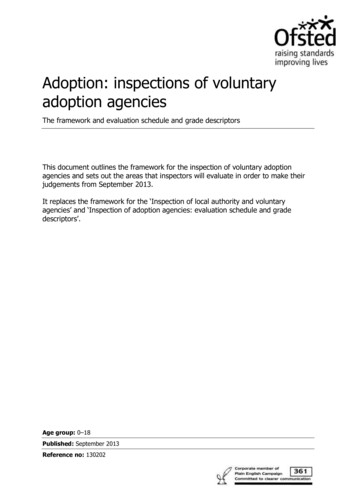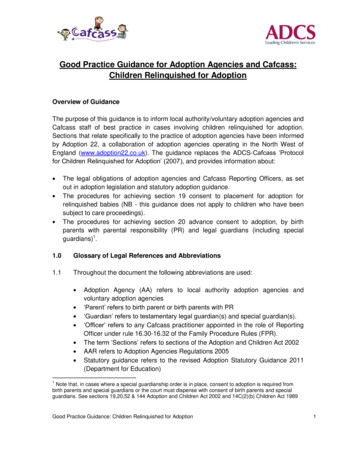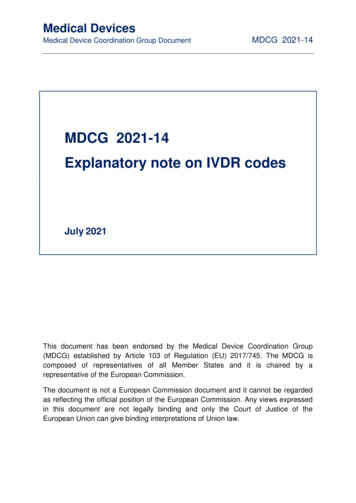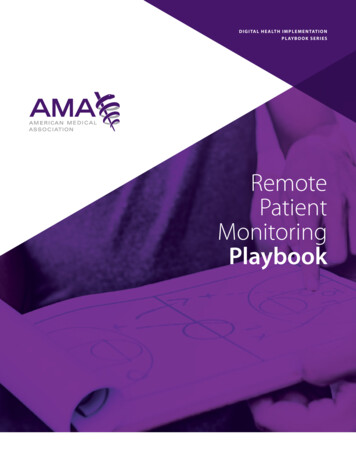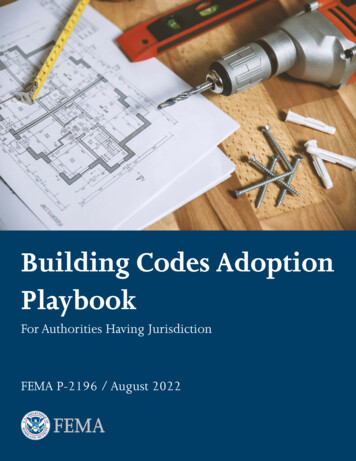
Transcription
Building Codes AdoptionPlaybookFor Authorities Having JurisdictionFEMA P-2196 / August 2022
This page intentionally left blank
IntroductionFEMA’s Building Codes Adoption Playbook for Authorities Having Jurisdiction (AHJ) is intended forofficials involved in adopting and enforcing building codes. The Playbook provides guidance to AHJsconsidering the adoption of the most current model building codes to mitigate damage and losscaused by future natural hazards. This is accomplished by providing general knowledge on theimportance of building codes, general steps to adopt and enforce them, information on FEMA grantsand references to additional resources.As a result of its long history with natural disasters and developing state-of-the-art, natural hazardresistant, design guidance and code change proposals, FEMA recognizes that buildings constructedin accordance with current codes protect lives and reduce the consequences of natural hazards.Because buildings generally have over a 50-year life span and comprise the largest subset of thenation’s infrastructure, the risk to the nation is incredibly significant. FEMA strongly encourages usingcurrent natural hazard-resistant codes and standards in the construction of new buildings and therepair, alteration and addition of existing buildings.EarthquakesHurricanesFloodsHigh WindsWildland FiresOther HazardsFigure 1. Natural Hazard EventsFEMA embraces local leadership, control and responsibility in its programs and policies. AHJs aregovernment agencies at the state, local, tribal and territorial (SLTT) level responsible for the adoptionand enforcement of building codes within their community. They can be composed of building,floodplain management, public works, zoning, planning, fire and other local government officialshaving authority in how or where buildings are constructed. Adopting and enforcing a comprehensivepackage of building codes and standards is crucial to community resiliency.Depending on state and local laws and regulations, AHJs may customize or amend their specificadoption and enforcement ordinances to meet their needs. However, the weakening of naturalhazard provisions is discouraged. FEMA encourages and, in some instances, incentivizes jurisdictionsto base their adoption ordinances on nationally recognized model building codes that reduce riskfrom natural hazards.Building codes, in general, refer to sets of requirements governing the design, construction,alteration, maintenance and use of buildings. They specify the minimum requirements toadequately safeguard building occupants’ health, safety and welfare.Model building codes refer to minimum design provisions and practices established bynationally recognized coordinating bodies made up of building professionals from all interestedorganizations. They are developed using consensus processes, they require the use ofreferenced national consensus standards and specifications and they can be used as templatesfor AHJs to use when developing their local ordinances.Authorities Having Jurisdiction adopt and enforce a comprehensive building code packageby ordinance. They can adopt the model codes in their entirety or amend them as necessarydepending on their laws and regulations.
BUILDING CODES ADOPTION PLAYBOOKTable Of ContentsOverview .1Building Codes 101 . 1Staying Current . 3Enforcement is Key . 3Validating Building Performance . 4Building Codes Save Lives and Money .5Life Safety and Equity . 6Economic Benefits . 6Climate Change . 7The I-Codes .8Overview of the ICC Code Development Cycle .9Tracking Code Adoption Nationwide .11Building Code Effectiveness Grading Schedule .11FEMA Building Code Adoption Tracking .11Maximizing FEMA Funding Opportunities . 13Incentivizing Adoption .13Building Resilient Infrastructure and Communities .13Other Building Code Funding Opportunities .18Code Adoption Checklists .19I
BUILDING CODES ADOPTION PLAYBOOKBuilding Code Adoption Checklist for Jurisdictions .20Recommended Adoption Checklist .20Statewide Building Code Adoption Checklist .22Recommended Legislative Action Checklist .22Recommended Regulatory Action Checklist .23Code Enforcement Process .24How Building Code Enforcement Works . 24Resources .26Acknowledgments .27II
BUILDING CODES ADOPTION PLAYBOOKOverviewBuilding Codes 101Natural hazards (such as earthquakes, hurricanes, floods, tornadoes, straight-line winds andwildfires) don’t occur every day, but when they do there can be severe consequences for acommunity. AHJs are in uniquely powerful positions to protect their communities through smartplanning and regulation. Adopting and enforcing current building codes that provide natural hazardresistance is an important tool that has been shown to save lives and money.Building codes are sets of minimum requirements governing the design, construction, alteration,maintenance and use of structures and are developed through consensus processes. From a desireto protect people’s lives, today’s code landscape has evolved into a formidable package of minimumbuilding requirements to protect building occupants as well as the public’s health, safety andgeneral welfare. They have continued to evolve to address accessibility, sustainability and the latestconstruction materials and methods. These include wide-ranging parent and companion buildingcodes, structural design standards, material-specific standards, voluntary standards and productquality specifications.LEGACY REGIONAL CODESNationalBuilding CodeUniformBuilding CodeCITIESSouthern StandardBuilding CodeREGIONALNATIONALFigure 2. Evolution of Building CodesBuilding codes developed naturally in the United States as technology and building scienceevolved and best practices were agreed upon. As depicted in Figure 2, building codes werefirst developed by larger cities in response to significant life-safety events. Over time, commonconstruction practices were identified on a regional level and became standard practice, leadingto the development of regional model codes. These regional model codes saved AHJs time andmoney by introducing a building code template. As the construction and materials industriesdeveloped nationally, the regional code-making bodies merged to form the International CodeCouncil (ICC) to provide model codes with building practices that were widely accepted across theentire country.1
BUILDING CODES ADOPTION PLAYBOOKMultiple entities develop model building codes including the International Code Council, NationalFire Protection Association and International Association of Plumbing & Mechanical Officials. FEMA’sprimary focus is on those nationally recognized model building codes that provide natural hazardrisk reduction including those hazards affected by climate change. Currently, the most widelyrecognized and adopted set of model building codes that address natural hazard resistance arepublished by the International Code Council and are referred to as the I-Codes.The flagship ICC model building codes are the International Building Code (IBC), the InternationalExisting Building Code (IEBC) and the International Residential Code (IRC). These three model codescan be considered parent codes that coordinate all other codes. Combined with discipline-specificcompanion codes, including fire, plumbing, mechanical and others, a comprehensive package isformed. This package includes referenced national consensus material and engineering standardsand product quality specifications, thereby incorporating the scientific understanding produced byspecialized organizations. Compliance with the referenced standards within each code is necessaryfor compliance with the code.It is important to note that model building codes do not carry the authority of law by themselves.They must be explicitly selected and adopted through ordinance by the AHJ to become legallyenforceable in accordance with state and local laws and regulations. AHJs should remember thatweakening the natural hazard-resistant provisions of the model codes through amendment increasesthe vulnerability of their communities. Examples of weakening natural hazard-resistant provisionsinclude, but are not limited to, removing flood elevation requirements or reducing seismic or windload design values.Additionally, building codes adopted and enforced by AHJs are typically non-retroactive. Therefore,even full adoption and enforcement of the latest model codes does not imply that all buildings inthe community are protected from future natural hazard impacts. Vulnerable existing buildings, evenif they are prohibited by current codes, do not trigger code enforcement actions. Within the IEBC,retrofit is only voluntary unless triggered by certain damage, alterations, additions or change ofuse. An AHJ could include additional mandatory retrofit requirements in its building code adoptionordinance or issue a special ordinance. For example, communities with earthquake risk shouldconsider retrofit or replacement of buildings constructed using unreinforced masonry.Going Beyond the MinimumBuilding codes represent a community’s minimum requirements for projects to protect life withinits jurisdiction. Property owners, designers, and builders can and should consider exceedingthese minimums to protect their investments and to make their communities more resilient tonatural hazards. Programs like FORTIFIED can be a tool for achieving higher levels of performanceand, in some areas, building to these standards can reduce insurance premiums. Also, severalFEMA products, such as FEMA 232, Home Builders Guide for Earthquake Resistant Designand Construction and FEMA P-804, Protect Your Property from High Winds: Wind Retrofit Guidefor Residential Buildings identify a series of “above code recommendations” to provide betterperformance.Ultimately, a qualified team of building design professionals can provide significant low-costimprovements in building performance if initiated early in the design process. What works toprotect from one hazard may also help to satisfy the needs of another hazard if thoughtfullydesigned.2
BUILDING CODES ADOPTION PLAYBOOKStaying CurrentModel building codes improve with each edition based on lessons learned, building scienceadvancements, engineering practices and technological advances. The I-Codes are updated on athree-year cycle and incorporate current information such as updated wind speed maps, snow loadmaps and seismic ground motion maps. The code update process is open to any interested partiesand includes hearings and public comment periods. Each code change proposal is evaluated to avoidunwarranted increases in construction cost. It is critical that states and localities adopt the mostcurrent edition of the model codes, and consider implementing a process to facilitate continuousadoption.!A majority of communities where natural hazard risk has been identified have not adoptedthe current or next most recent version of natural hazard-resistant building codes.For ways FEMA can help your community with building code adoption and enforcement, please readthe section “Maximizing FEMA Funding Opportunities.”Enforcement is KeyFor most AHJs, enforcement is a process carried out by a team of building code professionals. It canbe an official part of the AHJ’s governmental organization called the Department of Building andSafety or similar, a contracted function or some combination of the two. It includes building officialslike plans examiners and inspectors with specialized skillsets based on the occupancy, size, typeof the building, material of construction, or mechanical, electrical, plumbing systems. It may alsoinclude permit technicians, zoning, planning, fire or floodplain management officials. The 2021 IBCAppendix A describes this essential team’s best qualifications, experience, training and certifications.An adopted building code package is just words without enforcement. Brand new homes canstill be vulnerable to damage from small events if the AHJ’s code package requires componentssuch as anchor bolts to attach a house to its foundation, but they aren’t installed or installedincorrectly.For more information on enforcement, please read the section “Code Enforcement Process.”Paperwork by Scott Graham3
BUILDING CODES ADOPTION PLAYBOOKValidating Building PerformanceMitigation Assessment TeamFor over 30 years, FEMA has deployed Mitigation Assessment Teams (MAT) to assess theperformance of buildings in areas that were hit by natural hazards. The teams investigate why somebuildings were able to withstand the harsh effects of the natural hazard while others experienceddevastating damage. Through the MAT efforts, FEMA has conducted multiple post-hazardassessments and has released studies that show the proven benefits of adopting building codes.Figure 3 details how the lessons learned from such incidents feed into guidance, tools and codedevelopment.Lessons LearnedResearch to PracticeResearch/New KnowledgeReduced DisasterLossesGuidance andTools DevelopmentOutreach and ImplementationTECHNOLOGY TRANSFERBuilding Codes and StandardsHA Z ARD RESISTANCEFigure 3. Building Science CycleMAT studies have consistently shown that buildings constructed without implementing naturalhazard-resistant provisions performed worse than those that were built with those provisions.Following a deployment, FEMA publishes the observations and recommendations of a MAT in reports.Buildings that experience the most damage were often not built in accordance with a current code orwere built using older code editions. Correlating with the regular updates and improvements madeto model codes, buildings built to more recent code editions fared better than buildings built to oldereditions due to scientific advances.4
BUILDING CODES ADOPTION PLAYBOOKBuilding Codes Save Lives andMoneyOn January 12th, 2010, a magnitude 7.0 earthquake struck the island nation of Haiti. The event wascatastrophic, with an official toll of upwards of 300,000 fatalities. A main contributing factor to thehigh death toll was Haiti’s lack of earthquake hazard resistance in their buildings.On February 27th of that year, the country of Chile was struck by a magnitude 8.8 earthquake anda resulting tsunami. Although buildings sustained damage, the impacts were reduced due to Chile’sstrict building codes that were adopted in the aftermath of an earthquake experienced in the 1960s.Around 500 lost their lives in 2010.The struggles these two countries experienced teach us two important lessons:1.Natural hazard-resistant building codes work. While any life lost is a tragedy, thecommunities in Chile suffered less tragedy and death due to Chile’s decision toimplement building codes after an earthquake in the 1960s.2.Communities should be proactive and not wait to experience a disaster before choosingto protect themselves. One of the most impactful strategies for protecting buildings andsociety from natural hazards is the adoption and enforcement of natural hazard-resistantbuilding codes.“Strong, hazard-resistant building codes are a cornerstone of loss reduction.They save property, but more importantly, they save lives”.- FEMA Administrator, Deanne CriswellCommunities that have adopted and enforcedcurrent building codes have avoided at least 32billion in losses from natural hazards since 2000.It is estimated that the savings could accumulateup to 132 billion over the next 40 years. Whileadopting the latest building codes may seem costly,the added cost for natural hazard resistance is oftenquite small. The additional cost of roof tie-downs andwindow protection required by current codes in highwind regions of the country is, on average, less than2% of total construction costs and affords enormousfuture savings in avoided damages.20 Years 32 billionlosses avoided40 Years 132 billionlosses avoidedFigure 4. Future Savings from AdoptingCurrent Building Codes5
BUILDING CODES ADOPTION PLAYBOOKLife Safety and EquityBuilding codes are one of the most effective ways to ensure the safety of those within a communityduring a natural hazard. Between 2010 and 2020, the National Weather Service reported a ten-yearaverage of 94 tornado-related fatalities. In addition to that, the Natural Hazard Mitigation SavesStudy determined that about 1,600 people experience nonfatal injuries for every one fatality causedby natural hazards. In an effort to show the benefit-cost of natural hazard mitigation, the NaturalHazard Mitigation Saves Study also revealed that new buildings designed above the 2015 I-Codesedition would prevent the following:32,000 non-fatalinjuries each year20 deaths each year100 cases of PTSDeach yearBuilding codes can benefit all structures and communities. People with lower incomes tend toexperience greater challenges when natural hazards strike, especially if their home does notincorporate building codes. A way to help address this issue is to increase the natural hazardresistance of new affordable housing through the adoption of current building codes. Minimizingdamage through natural hazard resistance lessens the time it takes for these residents to recoverfrom a natural hazard and ensures all community members have the opportunity to live in a homethat keeps them safe against natural hazards.Economic BenefitsAlong with increased life safety and financialsavings from reduced damage, building codescan provide other economic benefits such asincreased property value and reduced insurancepremiums. Data from Verisk’s Building CodeEffectiveness Grading Schedule (BCEGS),Figure 5. FEMA P-2022, MAT Report:which classifies a municipality’s adoption andHurricane Harvey in Texas found thatenforcement of building codes, provides manyflood insurance claims of elevated homesbenefits to the community and the individual.required by current code were about 95%BCEGS classification can help lower insurancelower than non-elevated homes afterrates and boost grant opportunities for programsHurricane Harvey.such as FEMA’s Building Resilient Infrastructureand Communities Grant Program. Furthermore, the National Flood Insurance Program’s CommunityRating System is a voluntary incentive program that uses BCEGS data and encourages communityadoption of natural hazard-resistant building codes to exceed the minimum National Flood InsuranceProgram requirements. The Community Rating System incentivizes code adoption by discounting thecommunity’s flood insurance premiums where current model building codes have been adopted andenforced.6
BUILDING CODES ADOPTION PLAYBOOKAdditional StudiesFEMA has conducted and supported studies such as the Building Codes Save Study and NationalInstitute of Building Sciences (NIBS) Natural Hazard Mitigation Saves Study which evaluated the cost,benefits and the financial losses avoided in communities that implement building codes.Figure 6 highlights key findings from the Natural Hazard Mitigation Saves Study that showcase howadopting current natural hazard-resistant building codes benefits everyone.Mitigation CategoryCostBenefitBenefit-Cost RatioRiverine Flood 0.09 0.556:1Hurricane Flood 0.53 5.5510:1Earthquake 0.58 6.9012:1 1.20 13.0011:1Total for adopting 2018 I-CodesFigure 6. Costs and benefits associated with constructing new buildings to meet the 2018 IRCand IBC (in billions).Climate ChangeAs a result of climate change, natural hazards are becoming more frequent and intense. Acomprehensive building code package that includes minimum or even enhanced natural hazardresistant provisions is one of the best ways for communities to adapt to evolving risks posed bya changing climate. The evolution of natural hazard-resistant provisions in model building codesensures minimum requirements do not remain stagnant and better reflect a changing world.House in Massachusetts by Todd Kent7
BUILDING CODES ADOPTION PLAYBOOKThe I-CodesWhile the majority of this playbook is focused on building codes and building code adoption, thereare many different codes that are established under the ICC’s family of codes. Below is a briefoverview of ICC’s family of codes, as well as their importance.International Building CodeThe IBC consists of provisions that can apply to all new buildings.International Residential CodeThe IRC consists of provisions designed to address the natural hazard-resistance ofsingle-family houses, two-family houses and townhouses.International Existing Building CodeThe IEBC consists of provisions that apply to existing buildings undergoing repairs,alterations, additions or change of use. The IEBC is particularly useful in the repairof damaged buildings.The ICC develops 15 model codes used to regulatethe design and construction of buildings (seeFigure 7 for the other codes). Many of the codesfocus on discipline-specific applications that, whenpackaged together, will benefit the communitieswho adopt and enforce them. Codes such as theInternational Fire Code and International WildlandUrban Interface Code address making buildingsFigure 7. ICC I-Codes Suitemore resilient against fire events, includingexplosions and wildfires. Other codes, such asthe International Energy Conservation Code and International Green Construction Code, containprovisions for constructing buildings that conserve energy and are more environmentally friendly.In addition to code development, ICC also develops standards following the ANSI consensus-basedprocess. Some of these ICC standards are referenced in the I-Codes.For more information, please visit codes.iccsafe.org.8
BUILDING CODES ADOPTION PLAYBOOKOverview of the ICC CodeDevelopment CycleDid You Know?ICC develops national model building codes through the governmental consensus process.How often are codes developed or updated?New editions of the I-Codes are released every three years.The code development process occurs in intervening yearsand can be summarized as follows:1. Stakeholders, including members of the public, cansubmit proposed changes.2. Proposed changes are considered in open committeeand public comment hearings.3. The new code editions are finalized and published, andthe process starts again to develop the next edition.Who Serves on ICC Committees?Committee members are organized by one of threecategories:General:government regulatoryagenciesUser:building owners, designers,insurance companies, privateinspection agencies, academicsBuilders with Drawing by Pixy.orgProducer:builders, contractors,manufacturers, distributorsand labor9
BUILDING CODES ADOPTION PLAYBOOKHow can I participate?1Anyone can submit a code change proposal. If you believe there’s a code provision thatneeds to be added, improvement or removed, it’s as simple as visiting cdpACCESS tosubmit a code change.2Submit a public comment in favor or against any code change proposal in response tothe committee recommendations online by emailing memberinput@iccsafe.org.3Interested in joining a committee? Visit ICC’s Call for Councils and Committees toapply.4Testify in favor of or against any code change by attending Code Action Hearings.Visit the International Code Council’s Current Code Development Cycle page for information specificto the latest cycle.Construction Worker by Josh Olalde10
BUILDING CODES ADOPTION PLAYBOOKTracking Code AdoptionNationwideBuilding Code Effectiveness Grading ScheduleVerisk administers the Building Code EffectivenessGrading Schedule to participating communities. TheDid You Know?BCEGS program evaluates building code enforcementefforts at the jurisdiction level in three areas: codeBCEGS assigns each community aadministration, plan review and field inspection. Veriskrating of 1 (highest possible rating) tocollects and analyzes more than 1,200 data elements10 (lowest possible rating) based on itsto calculate scores for one- and two-family residentialcommitment to adopting and enforcingproperties and for commercial or industrial properties.building codes.Scores range from a minimum of 0 to a maximumof 100. Verisk translates the scores to a scaledclass rating from 1 (exemplary commitment to building code enforcement) to 10. Communities arereevaluated generally every four to five years nationally (every three years in Florida) or as substantialchanges are made to department operations. FEMA leverages some of this data for building codeadoption tracking and grants’ criteria. Note: BCEGS scores are proprietary to Verisk, but that Veriskalways shares the score with the community to which it pertains.For more information, contact Verisk’s mitigation team via email at BCEGS info@verisk.com or calltheir mitigation specialists at 1-800-444-4554.FEMA Building Code Adoption TrackingFEMA tracks the natural hazard-resistant buildingcode adoption status for state, local, tribal andterritorial governments, covering approximately 22,000jurisdictions across the nation. This effort, often referredto as Building Code Adoption Tracking (BCAT), evaluatesseveral aspects of a community’s natural hazard risksand building code adoption, including:22,000The approximate number ofjurisdictions for which FEMA trackscurrent building code adoption status. State or territory requirements for mandatory buildingcode adoption Building code adoption status for jurisdictions, including construction requirements forresidential and commercial Identification of known weakenings of natural hazard-resistant provisions.11
BUILDING CODES ADOPTION NHHINCTNARSCTXMSLAALGAFLHigher Resistance (75.0% to 100% of tracked jurisdictions are resistant)Moderate Resistance (25.0% to 74.9% of tracked jurisdictions are resistant)Lower Resistance 0% to 24.9% of tracked jurisdictions are resistant)Figure 8. BCAT Map of the United States grouped by FEMA regions (July 2022)BCAT PortalThe data FEMA has collected through BCAT ispresented through the BCAT Portal, which is aninteractive map designed through a web-basedgeographic information system that presents datadown to the jurisdiction level. The map tracks multiplenatural hazards and displays the following information: Code adoption information for CensusIncorporated Places Additional metadata such as the latest decennialU.S. Census population and National FloodInsurance Program Community Identificationnumber High-risk areas, code adoption and weakeningamendments viewable for each individual hazardor through a combined hazards layerFigure 9. BCAT PortalDid You Know?BCAT is a year-round endeavor. Theinteractive portal is updated everyquarter while the FEMA Regional factsheets are released every spring.12
BUILDING CODES ADOPTION PLAYBOOKMaximizing FEMA FundingOpportunitiesIncentivizing AdoptionNatural hazard-resistant communities begin with modern building codes. Looking for ways to fund morerobust codes in your community? FEMA offers a multitude of grants focused on helping communitiesto adopt and enforce building codes.iContact your state hazard mitigation officer for assistance on grant opportunities.Building Resilient Infrastructure and CommunitiesFEMA administers the Building ResilientInfrastructure and Communities (BRIC) grantprogram to help the nation un
BUILDING CODES ADOPTION PLAYBOOK . Overview . Building Codes 101. Natural hazards (such as earthquakes, hurricanes, floods, tornadoes, straight-line winds and wildfires) don't occur every day, but when they do there can be severe consequences for a community. AHJs are in uniquely powerful positions to protect their communities through smart
